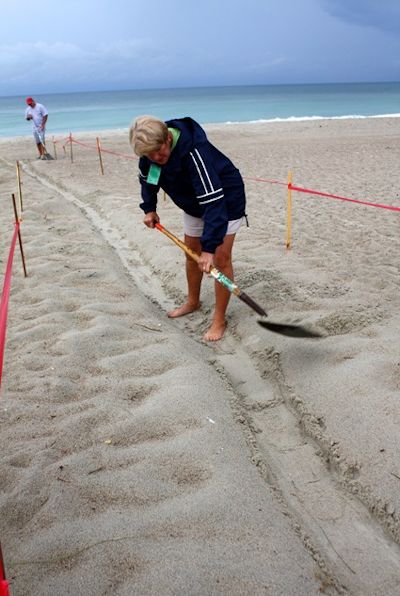 Volunteers clear a pathway from the nest to the ocean at Emerald Isle for the turtle hatchlings. Photo: Teri Saylor. |
EMERALD ISLE — On a damp August evening at the beach in Emerald Isle, a lull between downpours brought a group of men, women and children to the base of a dune marked off with bright pink plastic strips tied to four wooden stakes.
Three nights earlier, a sea turtle nest had hatched, sending a flood of baby turtles boiling up to the sand’s surface for their slow trek to the sea.
Supporter Spotlight
A dozen volunteers with the Emerald Isle Sea Turtle Project and about 50 spectators gathered to excavate the nest, eager to see how many eggs were inside and hoping to find more live hatchlings.
As Marsha Horner and Louise Ehrenkaufer dug into the nest with hands clad in blue rubber gloves, spectators celebrated and softly cheered for five little ones that had not made their way out of the nest when their brothers and sisters hatched earlier in the week.
Ehrenkaufer retrieved the hatchlings while Horner counted 81 empty shells.
A family vacationing from Virginia had been on the beach at 11 p.m. the night the eggs hatched.
“The baby turtles were very cute,” said Maggie Roberts of Alexandria, Va. “They scooted along the sand and used their little flippers to go and go. When they first hit the water, they tumbled over in the waves, but they figured it all out.”
Supporter Spotlight
Jenny Adams of Norfolk, Va., who had volunteered to count the tiny creatures as they came out of their nest, could barely keep up with them. “It was amazing,” she said. “I watched them bubble up, and counted them as they moved down to the ocean.”
Adams, Roberts and other family members had returned for the nest excavation.
Volunteers dug a smooth, shallow trench in the sand to make a path from the nest down to the ocean, a distance of about 100 feet.
The spectators leaned in close for a glimpse or to take photos with their phones as the turtles made their slow journey to the sea, their tiny flippers seeking traction and their little backsides sashaying back and forth.
The entire turtle parade took about 20 minutes.
Sea turtles laid 30 nests on Emerald Isle this season. The town on the western end of Bogue Banks is one of 21 sea turtle protection programs along the 330 miles of North Carolina’s beaches.
Endangered Species
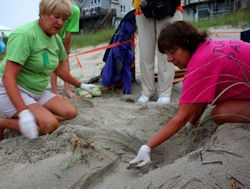 Marsha Horner, left, and Louise Ehrenkaufer discover straggling baby turtles left behind in this nest at Emerald Isle. |
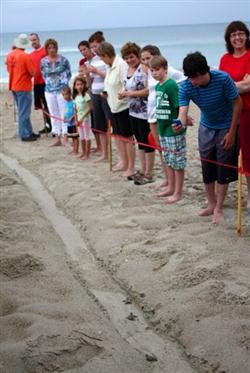 Baby turtles head down a clear path to the water at Emerald Isle. The babies always draw a crowd. Photos: Teri Saylor. |
Matthew Godfrey, a biologist with the N.C. Wildlife Resources Commission and director of the state’s Sea Turtle Project, reports the most common nesting species is the loggerhead, but green turtles, leatherbacks and a few Kemp’s Ridley sea turtle nests have been recorded on North Carolina’s beaches this year.
“All species of sea turtles in U.S. waters are listed as threatened or endangered by the U.S. Endangered Species Act,” Godfrey stated in an email. “The nest monitoring and protection project in North Carolina are part of this recovery process with the aim of boosting numbers so they are no longer threatened or endangered.”
Sea turtles have a strong survival instinct, but few make it to adulthood. Habitat loss, pollution, climate change, boat strikes and fishing mishaps are the turtles’ greatest threats. Hatchlings are the most vulnerable.
“They are the bottom link of the food chain,” said Emerald Isle volunteer Lois Craig. “Their survival rate is not good.”
If they are able to make it to the ocean without falling prey to a bird, fox or other predator, baby turtles must swim at least 30 miles on a journey lasting several days to reach the Sargasso Sea where they live in thick grass until they grow into 3-year-old juveniles. They start reproducing when they are about 25 years old.
Reproductive females return to the general region where they were hatchlings to lay their eggs, according to Godfrey. Turtles lay an average of four nests in a season, containing around 100 eggs each, and the eggs incubate for about 50 days.
Record Number of Nests
Some beaches up and down North Carolina’s coast are seeing record numbers of nests this season.
“We have found 227 nests so far this season, and we still have a few more weeks of nesting so we might see more,” said Jon Altman, a biologist with the Cape Lookout National Seashore. “This is the second-highest number of nests on our seashore in 22 years of keeping data.”
Cape Lookout recorded 242 nests in 1999. Officials counted 157 nests in 2010 and in 2011.
“We can’t totally explain the numbers,” Altman said. “Sea turtles are still mysterious to us. It takes them 30 years to reach maturity and some females don’t nest every year.”
Experts speculate the rise in numbers is due to the recent mild winters.
Altman thinks another factor may be new regulations that require shrimp boats to install turtle excluder devices on their nets to keep the creatures from getting entangled.
“In theory, if more turtles are surviving the shrimpers, we should have more turtles, but it will take more time to determine that,” he said.
 Ranger Renee Tomczik excavates a nest that didn’t hatch on Bear Island in Hammocks Beach State Park. Photo: Teri Saylor. |
Along the Cape Hatteras National Seashore, the turtle population sharply increased this year. Wildlife biologist Britta Muiznieks acknowledged it is hard to pinpoint why turtles laid 222 nests this season, compared to 147 in 2011 and 153 in 2010.
“2004 was a poor year, with just 43 nests, total, but since then, the numbers have steadily increased,” she said. “We have seen a drastic improvement, but it is really hard to say why.”
She noted fewer turtle strandings this year too.
Renee Tomczik, a park ranger at Hammocks Beach State Park, headed out on a bright Sunday morning to excavate nests on the park’s Bear Island with Bobbie and Duane Jastremski.
“Our summer interns patrol the beach looking for mama turtles or their crawl marks. You can’t miss them. They look like big tractor tracks where their flippers dig deep into the sand,” Tomczik said.
Bear Island had 25 nests this season compared to 37 nests in 2011 and 19 in 2010.
Bear Island Turtles
A Bear Island nest targeted for excavation was easy to spot. A shallow hole punctuated a marker that had been placed when the nest was discovered earlier in the summer.
High tides and heavy winds had added nearly a foot of sand to a nest that should have been no more than 24 inches deep. Tomczik lay face down on the beach and reached in as far as she could to pull empty shells out. Bobbie Jastremski counted. The team retrieved 90 empty shells, one egg that did not hatch and a dead hatchling.
Another excavation on the island yielded 106 eggs that never hatched. Tomszik blamed higher than usual tides that packed the sand and created unfavorable conditions.
“Overall in North Carolina the emergence success of all nests is around 65 percent,” Godfrey said. “In years with intense hurricane and storm activity, it can be lower, and in calm years, it can be higher.”
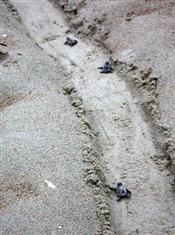 |
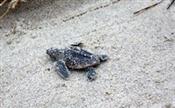 |
 A baby turtle makes it to the surf at Emerald Isle. Photos: Teri Saylor. |
Terry Meyer, who directs the Topsail Island Sea Turtle Nesting Program, said this year appears to have been a good one for North Carolina, but just average for her area.
“It was not a banner year for us,” she said. “Over the past couple of years, we have had more than 100 nests. This year we had 82.”
The N.C. Wildlife Resources Commission started keeping records in 1997, according to Godfrey, and has posted statistics from 25 nesting areas its Web site. While those records are incomplete before 2010, the numbers indicate a slight uptick statewide over the last three years, with 883 nests recorded in 2010, 967 nests in 2011 and 1,087 in 2012.
“Time to maturity (for sea turtles) is around 40 years, and we wouldn’t expect to see our impact on nest protection in the nesting population for several decades,” Godfrey said. “Bottom line, it is too early to tell if the nest protection efforts are helping.”
Jenny Adams, the vacationer who helped count the Emerald Isle hatchlings was excited about her role in helping the babies complete their journey to the sea. “I felt like I was sending my kids off to college,” she said. “This was not on my bucket list before, but I just put it there and crossed it off.”
As the sun set at Emerald Isle, it started raining, and the crowd dispersed. The volunteers covered the nest, burying the egg shells and they took down the barriers. Their job was done.
As they walked away, they left no sign that anything exciting had happened on this spot. But if you looked closely at the sand where the tide was beginning to come in, you could still make out tiny faint turtle tracks disappearing into the sea foam.







